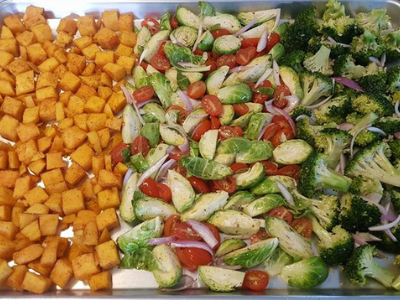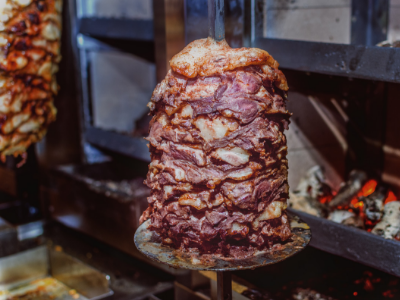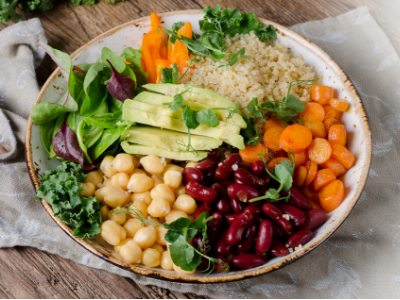I’ve never liked to cook. Many years ago, when I started trying to make better food choices, I tried forcing myself to cook in hopes that I’d eventually learn to enjoy it. It wasn’t until recently I finally came to terms with the cold, hard truth: I loathe cooking.
However, I love eating, and it’s important to me to eat healthy, so I chose to look at my disdain for cooking as an opportunity to figure out how to do so using minimal amounts of really simple cooking.
Before we go on, let’s consider what it means to “eat healthy.”
What Is Healthy Eating?
If we asked a dozen people their definition of healthy eating, we would get a dozen very different answers. Healthy eating depends on several factors, which means it won’t look the same from one person to the next. Here are four things that are often overlooked when one creates their own unique definition of healthy eating.
Cultural Considerations
Healthy eating can look quite a bit different depending on a person’s culture. For example, my own family is Japanese. In Japanese culture, not only is rice considered healthy, but it’s served with nearly every meal, whereas here in the United States that amount of carbohydrate might be considered unhealthy by some.
This is only one of many examples, but it’s important to take an individual’s culture into consideration when determining what healthy eating may look like for them.
 Economic Considerations and Availability
Economic Considerations and Availability
Healthy eating will also look different based on a person’s budget, and which foods are available to them. These are two very important things that need to be factored in. Not everyone has the same means or access to the same foods.
Personal Preference
Some people may view certain food items as healthy, even though they personally despise the flavor, texture, or both. If they try to force themselves to eat those foods anyway, they may end up dreading their meals at best, and creating a problematic relationship with food at worst.
While every meal you eat may not be worthy of winning culinary awards, I think it’s fair to say that your food should, at the very least, be tolerable in order for it to be considered healthy for you.
Food Allergies and Sensitivities
If an individual has a sensitivity or an allergy to certain foods, these foods will not be healthy for them to eat — and could instead be quite harmful — regardless of the fact that they may be considered “healthy” by some.
As you can see, healthy eating is much more involved than simply following a certain diet or popular nutrition protocol.
Healthy eating will always be unique to the individual; there is not one size that fits all.
Embrace Short Cuts
I’ve had countless clients tell me they feel guilty for taking short cuts when it comes to preparing healthy meals. They seem to feel like healthy meals don’t “count” unless they do all of the washing and chopping, and prepare the meal from scratch.
While I applaud the intention, find peace in knowing that long and intricate preparations are not necessary for healthy meals unless you genuinely enjoy the process. Additionally, the easier you can make things on yourself, the more consistent you will likely be, and consistency will always reign supreme for getting results, regardless of what the goal is.
Taking available short cuts for the sake of consistently preparing healthy meals you enjoy is an act of self-care.
Fruit and Vegetables
No matter what your unique definition of healthy eating is, it’s probably safe to assume that you believe that fruit and vegetables are beneficial. In my experience working with hundreds of women, fresh produce is often perceived as tricky because it’s highly perishable.
We can get around this by buying either frozen or canned, both of which are more cost effective than buying fresh.
Many frozen vegetables now come in their own steamer bags, making it easy for you to cook them in the microwave in a matter of minutes! Add a bit of butter, or a sprinkle of cheese, or just some salt and pepper and you can add them to any meal. (When I worked in an office I would take steamer bags of veggies with me and cook them at work to go with my lunch — it doesn’t get easier than this.)
Otherwise, you can quickly thaw frozen fruit and vegetables in the microwave if you prefer to prepare them a different way. And of course you can slowly thaw these in your fridge if you are planning ahead.
Frozen and canned produce don’t seem to get much attention, but can be an easy, fast, and healthy addition to meals without much cooking required.
 If you prefer fresh vegetables and have the means to opt for this, many stores offer a wide variety of pre-washed and pre-chopped vegetables. Grab your favorites, dump them onto a baking sheet with a drizzle of olive oil and your favorite seasonings and bake them all at once. This will provide you with plenty of delicious vegetables for the next several days.
If you prefer fresh vegetables and have the means to opt for this, many stores offer a wide variety of pre-washed and pre-chopped vegetables. Grab your favorites, dump them onto a baking sheet with a drizzle of olive oil and your favorite seasonings and bake them all at once. This will provide you with plenty of delicious vegetables for the next several days.
Another trick that I love is getting a bunch of pre-chopped vegetables from the salad bar at the grocery store and then cooking them into a big stir-fry once I get home, which also provides plenty of leftovers.
Protein
We encourage women who regularly engage in exercise and resistance training to consume moderate amounts of protein.
If you consume animal products, frozen burger patties are really easy. They are available at many groceries stores, and come in beef, turkey, chicken, bison, and different types of fish. You can cook them from frozen in a skillet in less than 10 minutes. Add your favorite burger toppings, and you’re in business in less than 15 minutes. You can also prepare several at a time for leftovers!
Additionally, you can find prepared sources of protein at many grocery stores, such as rotisserie chicken, hard-boiled eggs, pre-cooked sausage, and deli meat. These are convenient additions to almost any meal.
Note: whether or not a person chooses to consume cured meats, or how much of them, is a decision for them and their body.
 Another trick that I recently discovered is buying cooked diced chicken and steak from local burrito shops or Middle Eastern counters. While they don’t necessarily advertise it, they often sell meat by the pound if you ask them. This has been an incredibly easy (and delicious!) way to add protein to salads, burritos or wraps, on top of pizza, or to eat by itself.
Another trick that I recently discovered is buying cooked diced chicken and steak from local burrito shops or Middle Eastern counters. While they don’t necessarily advertise it, they often sell meat by the pound if you ask them. This has been an incredibly easy (and delicious!) way to add protein to salads, burritos or wraps, on top of pizza, or to eat by itself.
For those who don’t eat meat or prefer not to have meat or eggs at every meal, you can add quinoa, different kinds of legumes, and cottage cheese to your meals. Quinoa and legumes require very little prep, and cottage cheese is simply a matter of opening the container!
These are just a few examples of easy foods that contain some protein, and that may also provide you with carbohydrate.
Carbohydrate and Dietary Fat
Carbohydrate and dietary fat are two things that don’t require much preparation at all, and are usually easy additions to a meal. Boiling or steaming some rice (in a rice cooker or in the microwave), or baking potatoes are two examples.
Dietary fat can be incorporated effortlessly into most meals, and it can significantly boost their flavor. Drizzling your vegetables with olive oil or coconut oil, sprinkling a little cheese onto your meal, slicing up some avocado, or adding some butter or ghee takes less than 60 seconds, and is nearly effortless.
Of course, these are just a few examples of dietary fat, but it can be easy to keep it simple.
 Putting Things Together
Putting Things Together
When it comes to preparing healthy meals, the two things that seem to require the most preparation are protein and produce. Once you have those selected, all you need to do is add the appropriate amount of carbohydrate and dietary fat for your unique needs and you’ve created a meal!
While it can be tempting to assume things need to be complicated with a lot of prep and cooking time, it doesn’t have to be. By having a few staples and switching up what you add to the meal, it can be really easy, fast, delicious, and healthy.
My recommendations are based on my culture, availability, and means. However, by broadening your own definition of what “healthy eating” means, you can open up new possibilities for different foods, flavors, and preparation styles. This can improve your consistency with healthy eating, all while learning to think in a more inclusive manner, too!
